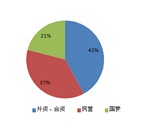After the 531 New Deal in China's PV industry, the industry is filled with confusion and pessimism.
As an industry that is heavily influenced by policy, subsidy reduction and scale control do have a huge impact. However, China's PV industry is constantly expanding in this way. From the freezing period of the European market to the double-counter attack in Europe and the United States, Chinese PV companies have gone through a hurdle!
From the perspective of longer-term development, the market prospect of photovoltaics is far from the top. We have reason to believe that the twists and turns are only a turning point in the bright future. The sunrise of the photovoltaic industry has only just risen. We must have firm confidence that the future must be Great!
Du Xiangyu, an academician of the Chinese Academy of Engineering and former vice president, recently gave a speech at a relevant meeting. From his speech, PV people may find a lot of confidence and strength:
"In China's electricity, the proportion of non-fossil electricity is now 30%. It can reach 35% in 2020, 48% in 2030, and 78% in 2050. Although the volume is not necessarily very accurate, this trend It is very clear. In the future, renewable energy will become the dominant energy source," Du Xiangyu said in his speech.
Academician Du’s speech is high-rise, and his views on energy development are very far-sighted. Huaxia Energy Network has specially edited and organized it. Let’s take a look at what the failed energy picture seen in the eyes of academicians.
There are three historical stages in the global energy structure transformation. The first phase was a coal-based phase. 100 years ago, coal accounted for 70% of the global energy mix; but later, the global oil and gas ratio exceeded 50% in the energy mix. The second stage is the stage of oil and gas. After several decades of development, this stage will move to the third stage, which is the non-fossil energy-based stage. The growth of wind power and photovoltaic power generation in the world is very obvious.

Global renewable energy investment is more than twice that of other energy sources. The EU plans to increase the proportion of renewable energy to 20% by 2020, 32% in 2030, and 20% in China. There are four reasons for this to develop renewable energy: first, to improve air quality; second, to respond to climate change; the International Energy Agency plans to reduce greenhouse gas emissions by 32% by 2050; the third renewable energy is available on Earth. Sustainable development; the combination of the fourth renewable energy and the Internet makes its economy more viable.
The development of China's energy structure is also in three stages. The first phase is also based on fossil energy, with fossil energy accounting for more than 90%. The second stage is not the same as the global one. It will not be dominated by oil and gas. Instead, the proportion of natural gas is even larger. Now natural gas accounts for 7%, and oil is 17%-18%. Oil and gas add up to more than 50% in China, so China has now entered the second stage, called the multi-structure stage, in line with China's actual situation. In a multi-structure, coal, oil, gas and renewable energy coexist. After going through a process of decades, it will eventually lead to a stage dominated by non-fossil energy. At this point, the world is consistent, and low-carbon energy will gradually become the global conventional energy source.
China's green low-carbon energy development strategy has three pillars: the first energy-saving priority and energy efficiency; the second coal and oil's efficient and clean utilization, increasing the proportion of natural gas; and the third, high quality, high proportion to increase renewable energy utilization.
















 RCCN WeChat QrCode
RCCN WeChat QrCode Mobile WebSite
Mobile WebSite







